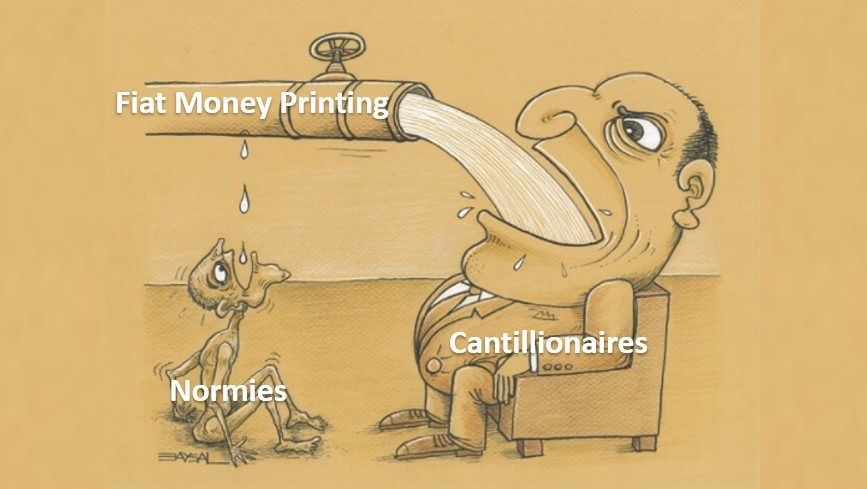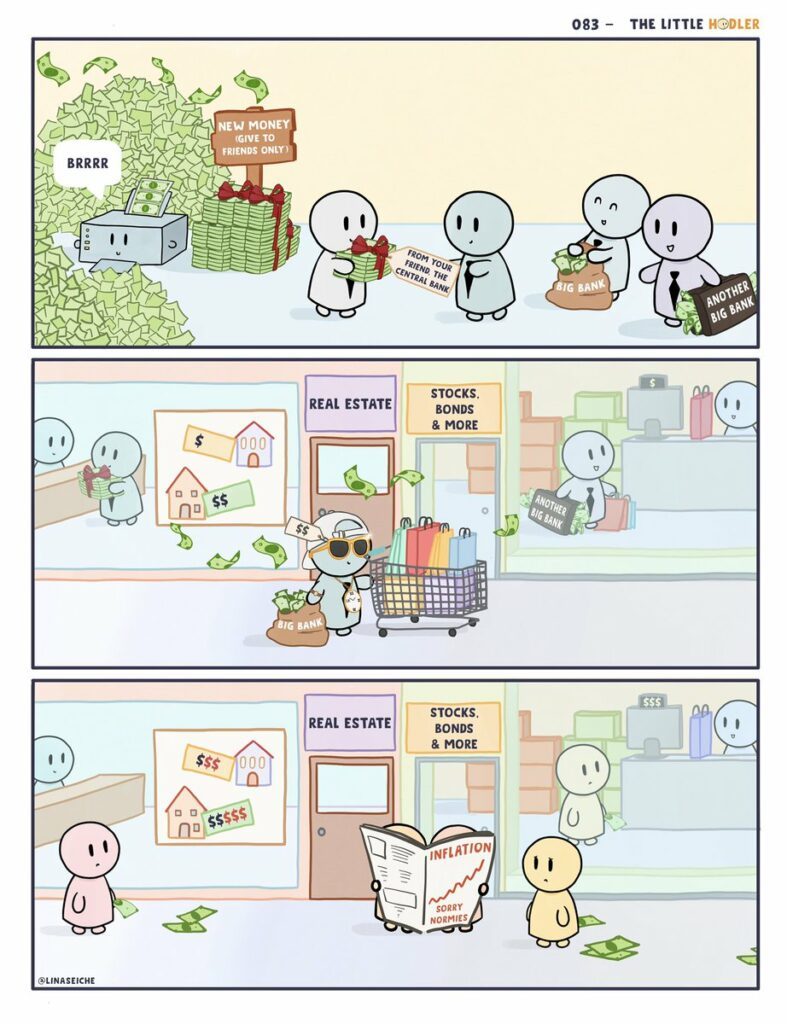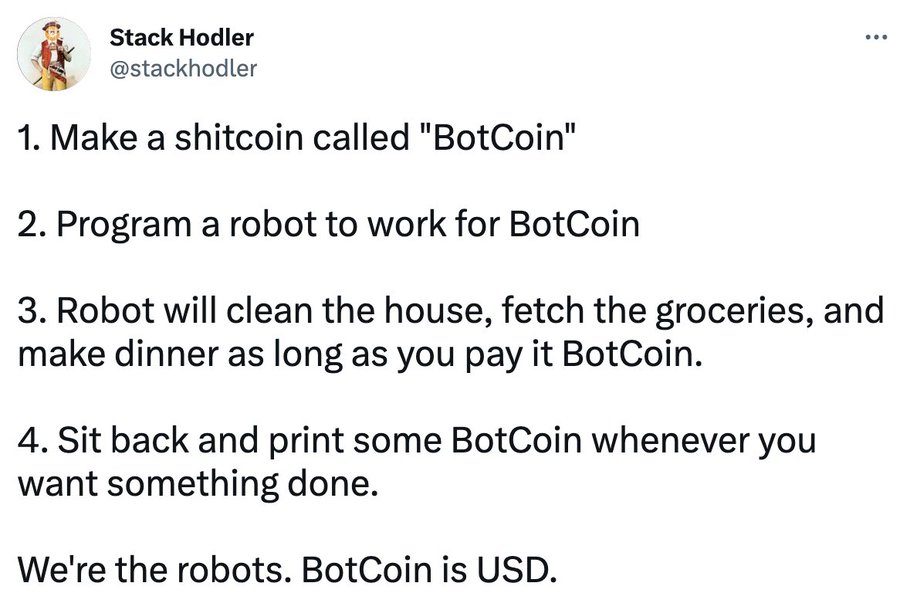What is the Cantillon Effect? The Cantillon Effect refers to the uneven impact of changes in the money supply on different economic groups.
It highlights how those who receive new money early, such as financial institutions, benefit more than those who gain access later, leading to disparities in wealth distribution.
The Cantillon Effect describes the uneven effect inflation has on goods and assets in an economy.
Since new fiat money is injected into an economy at specific points, its effects are felt by different people and industries at different times.
This causes a distortion in relative prices and benefits certain parties while disadvantaging others.

Quick Take: What is the Cantillon Effect?
The Cantillon Effect: Named after 18th-century economist Richard Cantillon, this phenomenon dissects how monetary policies impact wealth distribution.
Uneven Impact: Monetary changes don’t uniformly affect all sectors. New money’s entry sequence creates winners and losers.
Wealth Distribution: Initial recipients, like financial institutions, gain from new money. Inflation follows, burdening fixed incomes and those without direct access.
Disparity Amplified: Asset holders profit from inflated prices, while latecomers suffer. Stocks and real estate artificially inflate due to new money infusion.
Strategic Insight: The Cantillon Effect’s comprehension aids policymakers, economists, and the public. Proactive policy adjustments can ensure fairer wealth distribution.
Inclusive Growth: Directing resources to sectors impacting small businesses and wage earners mitigates disparities, fostering balanced economic progress.
Power of Policies: The Cantillon Effect’s unequal wealth distribution underscores the need for vigilance and innovative solutions such as Bitcoin.
Shaping Tomorrow: By avoiding the the Cantillon Effect, society moves towards a more equitable and prosperous future.
What is the Cantillon Effect Comic – The Little Hodler
The Little Hodler comic explains the Cantillon Effect in a brief comic strip:
First the money supply is inflated as money printer goes “brrrr”.
The people close to the fresh cash distribute it to the friends, the big banks and big corporate entities.
The “cantillionaires” then go shopping and scoop assets and real estate at low prices.
This artificial demand drives up prices all around. The normal people will suffer because even if they get a 2% salary increase, they’ve already paid 5% or 10% higher prices for years.
If you’ve got a friend who wants to know “what is the cantillon effect” send him this picture.

What Is the Cantillon Effect: Unraveling Economic Disparities
In the intricate web of economics, a phenomenon known as the Cantillon Effect has garnered increasing attention for its profound influence on wealth distribution.
Named after the 18th-century economist Richard Cantillon, this concept revolves around the uneven impact of monetary policies and their subsequent effects on various economic strata.
Delving into the essence of the Cantillon Effect unveils a world where money flows dictate winners and losers, shaping the economic landscape in unexpected ways.
The Cantillon Effect Demystified
At its core, the Cantillon Effect elucidates how changes in the money supply don’t uniformly affect all individuals and sectors within an economy.
Traditional monetary policies, such as quantitative easing or interest rate adjustments, inevitably lead to the redistribution of wealth.
This phenomenon arises due to the sequence in which new money enters the economy – not everyone gains access to it simultaneously.
Implications for Wealth Distribution
In the wake of monetary injections, the first recipients of the new money often enjoy a distinct advantage. Typically, these beneficiaries are financial institutions and wealthy individuals closely connected to the central banking system.
As the new money permeates the economy, its purchasing power diminishes, translating to higher prices for goods and services. This inflationary pressure disproportionally burdens those on fixed incomes or with limited exposure to the initial monetary injection.
Small businesses and wage earners, who lack direct access to newly created money, find themselves grappling with rising costs without a commensurate increase in income. They’re often less educated and never ask themselves “what is the cantillon effect”.
The widening gap between asset holders and wage earners is a hallmark of the Cantillon Effect, casting a shadow on social and economic equity.
Unveiling the Chain Reaction
The Cantillon Effect sets off a chain reaction across sectors. Asset prices, such as real estate and stocks, often experience an artificial inflation due to the infusion of new money.
Insiders who have early access to these assets profit handsomely. However, the majority, who enter the market later, encounter inflated prices that erode their purchasing power.
Navigating the Economic Landscape
What is the Cantillon Effect is an important question and it is crucial for policymakers, economists, and the general public alike.
Anticipating the repercussions of monetary policy changes can enable more equitable wealth distribution strategies. Policymakers can strive for inclusive growth by directing resources toward sectors that directly impact wage earners and small businesses.
In conclusion, the Cantillon Effect serves as a stark reminder that monetary policies possess the power to shape economic destinies.
Its unequal distribution of wealth highlights the need for vigilant oversight and innovative solutions to foster a fairer economic landscape. By acknowledging the intricacies of the Cantillon Effect, society can work towards a more balanced and prosperous future for all.
Does the Cantillon Effect Apply To The US Dollar?
Now we’ve got many answers as to what is the Cantillon effect but one question might remain. Is the US dollar affected? Yes, the Cantillon effect applies to the US Dollar.
When new money enters the economy through policies like those of the Federal Reserve, its benefits aren’t distributed equally.
Initially, entities like banks and large corporations gain the most, potentially causing asset price inflation. As the money circulates, inflation can harm those with fixed incomes. This highlights the uneven impact of monetary policy on different parts of the population.

How can you avoid the Cantillon effect?
Can you shield yourself against the devastation of the cantillon effect? If you understand basic economics it’s much easier than you might think to either profit from the system or just reduce the harm it does to your dollar savings.
Here are some ideas how you can protect your money.
1. Invest in Hard Assets: Hard assets like precious metals (gold, silver, etc.) have historically acted as stores of value, preserving wealth during economic uncertainties and inflation. Investing in hard assets can be a hedge against the devaluation of fiat currency. By holding physical assets, you reduce exposure to the Cantillon Effect and potential currency devaluation.
2. Embrace Bitcoin: Bitcoin, as a decentralized digital currency, offers an alternative to traditional fiat currencies. Its limited supply, capped at 21 million coins, mitigates the risk of excessive money printing that contributes to the Cantillon Effect. Investing in Bitcoin can provide a hedge against currency devaluation and unequal wealth distribution, making it a valuable addition to a diversified portfolio.
3. Implement Dollar-Cost Averaging (DCA): DCA involves investing a fixed amount of money at regular intervals, regardless of asset price fluctuations. This strategy minimizes the risk of timing the market and helps reduce the impact of short-term volatility. By consistently investing over time, you avoid the potential negative effects of sudden money creation and subsequent inflation caused by the Cantillon Effect.
Steps to Set Up a DCA Strategy:
- Determine Investment Amount: Decide how much you’re comfortable investing regularly, considering your financial situation and long-term goals.
- Choose Frequency: Decide on the frequency of investments, whether weekly, monthly, or quarterly. This regularity helps ensure you’re buying both during market highs and lows.
- Select Investment Platform: Choose a reliable investment platform or exchange that allows you to set up automated recurring purchases. This streamlines the DCA process.
- Stick to the Plan: Commit to your DCA strategy and avoid making emotional decisions based on short-term market fluctuations. Consistency is key to its success.
Benefits of Combining Strategies:
- Diversification: A combination of hard assets and Bitcoin offers a diversified approach to hedging against the Cantillon Effect and currency devaluation.
- Long-Term Perspective: Both hard assets and Bitcoin have shown resilience over time, making them suitable for a long-term investment strategy.
- Mitigated Volatility: DCA minimizes the impact of price volatility, allowing you to accumulate assets at various price points and potentially benefiting from market dips.
- Reduced Exposure to Cantillon Effect: By investing in assets with limited supply and value preservation qualities, you reduce vulnerability to the effects of excessive money creation.
Considerations and Risks:
- Research: Thoroughly understand the financial system and technicalities of Bitcoin.
- Market Volatility: Despite DCA, market volatility can still impact the value of your portfolio in the short term.
- Long-Term Commitment: Both hard assets and cryptocurrencies are better suited for long-term holding rather than short-term speculation.
In summary, countering the Cantillon Effect involves diversifying your investments into hard assets like precious metals and Bitcoin. By combining these with a Dollar-Cost Averaging strategy, you reduce the impact of sudden money creation, inflation, and currency devaluation. These strategies provide a means to protect your wealth and financial well-being in an ever-changing economic landscape.









